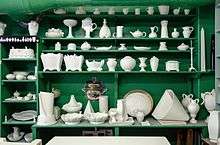Slipcasting


Slipcasting or slip casting is a technique for the mass-production of pottery and ceramics, especially for shapes not easily made on a wheel. Slipcast ware should not be confused with slipware, which is pottery formed by any technique that is decorated using slip. In slipcasting, a liquid clay body slip (usually mixed in a blunger) is poured into plaster moulds and allowed to form a layer, the cast, on the inside walls of the mould.
In a solid cast mould, ceramic objects such as handles and plates are surrounded by plaster on all sides with a reservoir for slip, and are removed when the solid piece is held within. For a hollow cast mould, for objects such as vases and cups, once the plaster has absorbed most of the liquid from the outside layer of clay the remaining slip is poured off for later use. After a period for further absorption of water, the cast piece is removed from the mould once it is leather-hard, that is, firm enough to handle without losing its shape. It is then "fettled" (trimmed neatly) and allowed to dry out further, usually overnight or for several hours. This produces a greenware piece which is then ready to be decorated, glazed and fired in a kiln.[1]
The technique is suited to the production of complex shapes, especially if with relief decoration and thin walls. Much modern fine factory porcelain is made by the techique, very often the entire production. It is also commonly used for sanitaryware, such as toilets and basins, and smaller pieces like figurines and teapots.[2] The technique can also be used for small-scale production runs or to produce limited edition, one off objects, especially reproductions of antique dolls and modern porcelain doll-making.
An additive with deflocculant properties, such as sodium silicate, can be added to the slip to disperse the raw material particles. This allows a higher solids content to be used, or allows a fluid slip to be produced with the a minimum of water so that drying shrinkage is minimised, which is important during slipcasting.[3]
The French for slip is barbotine ("Coulée en barbotine" is slipcasting), and "barbotine pottery" is sometimes used for 19th century French and American pottery with added slipcast decoration, as well as (confusingly) being the English term for a variety of slipware that is decorated with thick blobs of slip.
References
| Wikimedia Commons has media related to Slipcasting. |
External links
- "How it's made: Ceramic Slip Casting", video, duration 1:20
- "Slip Casting at the Emma Bridgewater factory in Stoke-On-Trent, England" video, duration 2:29